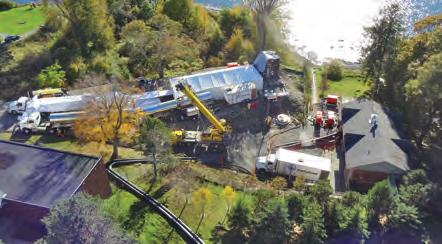
4 minute read
Northwest Arm Trunk Sewer Rehabilitation
AWARD OF EXCELLENCE
Robinson Consultants
With CIPP, on-site fabrication and installation were feasible without disrupting the public’s use of the shoreline during construction.

“This challenging project, which broke several Canadian records, was completed on a very tight schedule, caused minimal disruption to the neighbourhood and saved considerable money compared to alternate methods.” –Jury
Halifax Water required the renewal
of an inaccessible, 100-year-old, largediameter, 4,000-m long trunk sewer that was exfiltrating into the Northwest Arm inlet, a major recreational and natural asset, during rain events.
Robinson Consultants was tasked with restoring both the sewer’s structural integrity and its intended flow capacity, extending its service life up to 75 years, removing debris, creating a corrosion barrier and eliminating contamination of the coastline. The project was executed in a cost-effective manner while significantly reducing social and environmental impacts.
Constraints
The Northwest Arm Trunk Sewer (NATS) was one of the most challenging cured-in-place pipe (CIPP) rehabilitation projects ever completed in North America. Several Canadian records were broken in the completion of this project, including the longest single continuous CIPP installation length at 682 m.
The project's engineering scope included closed-circuit television (CCTV) inspection, condition assessment, feasibility study, constructability, detailed design, tendering, contract administration and site inspection for the rehabilitation of more than 4,000 m of combined trunk sewer, ranging from 1,200-mm diameter round pipe to 1,200 x 1,500-mm arch pipe, located in some of the most difficult-to-access residential terrain in Halifax.
The NATS alignment meanders along the inlet’s shoreline anywhere from 0 to 10 m from the water’s edge and is landlocked by a Canadian National (CN) Railway track with bridge access only. In terms of access challenges, it is located mainly on built-up, multimillion-dollar historic residential waterfront properties, steep shoreline slopes, 100-yearold load-restricted CN bridges and a hydroelectric corridor.
The project was financed by the Clean Water and Wastewater Fund (CWWF) with an ambitious timeline for completion. While a typical project of this size and magnitude would take more than 12 months of planning and engineering, the team was able to successfully complete all such requirements in seven months to meet the schedule.
Non-standard design
CIPP design standards under ASTM F1216, Standard Practice for Rehabilitation of Existing Pipelines and Conduits by the Inversion and Curing of a ResinImpregnated Tube, are based on circular
Northwest Arm Trunk Sewer Rehabilitation, Halifax
Award-winning firm Robinson Consultants, Ancaster, Ont. (Kevin Bainbridge, A.Sc.T.; (prime consultant): Patrick Moskwa, P.Eng.; Ian Doherty, P.Eng.). Owner: Halifax Water.
Other key players: CBCL (hydraulic modelling and mechanical engineering).
AWARD OF EXCELLENCE
sewers. This project required a unique approach to develop a non-circular CIPP design for arch-shaped portions of the sewer, which totalled approximately 2,000 m in length.
The team assessed the pipe crosssection in three distinct components: arch top, vertical sides and dished bottom. The design parameters for each of these individual components were established, along with equations to identify the CIPP thickness required to meet the expected loads. This methodology expanded upon the traditional limitations of CIPP technology.
Logistical challenges
Due to the challenges presented by the sewer’s off-street path through residential backyards (whose owners were engaged during the project) and steep terrain, approximately 3,000 m of the total 4,000 m of CIPP was installed from just four small access footprints, at lengths in excess of 400 m compared to typical lengths of 100 to 150 m.
Further, on-site CIPP fabrication was required to limit the weight of material trucks, so they could enter the area over the aforementioned load-restricted bridges.
The sewer’s existing condition also required removal of more than access locations. In some cases, this meant pulling debris over lengths in excess of 500 m.
An appealing alternative
CIPP is a structurally sound pipe installed within an existing pipe. The typical methodology of opencut pipe replacement through the shoreline would have had heavier social, environmental and economic impacts. The installation of a new pipe would have required the excavation of a 4,000-m long, 4-m wide and 8-m deep trench, removing 80,000 m3 of earth and rock, damaging terrestrial and aquatic habitats along the coast.
It is estimated the cost savings of using CIPP were between 50 and 60% versus replacement and the construction period was reduced by six to eight months. While some minor excavation was needed at existing maintenance holes, no linear length of sewer pipe required excavation. The public was able to continue to use the recreational shoreline during construction and the risk of spilling sediment and other contaminants
750 m3 of heavy debris from five

into the inlet was reduced. CCE
Smart IoT Compressed Air Device Delivers Advanced System Diagnostic and Energy Efficiency
Saving energy is easier than ever before thanks to the MSE6-E2M. Achieve your energy efficiency and sustainability targets while optimizing process equipment performance. Intelligent assembly features include: • Zero compressed air consumption in standby mode • Monitors the system for leaks • Ensures maintenance in the event of leaks • Enables effective real-time monitoring of relevant process data










